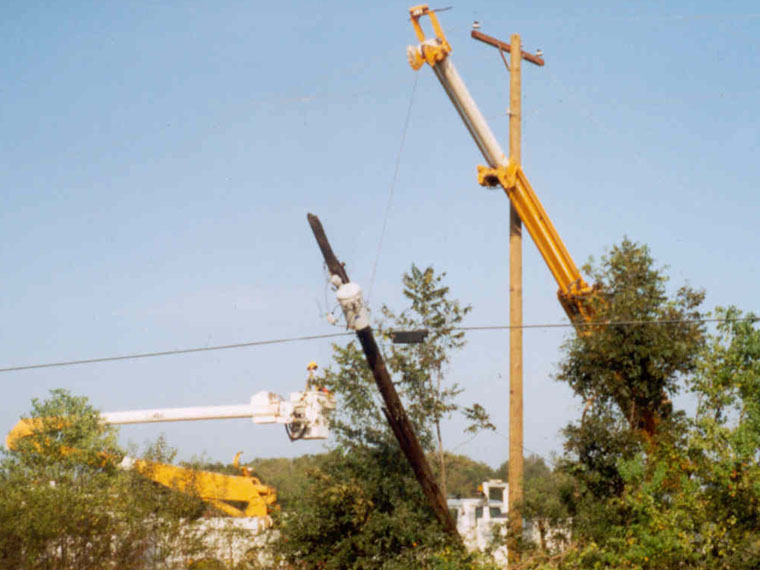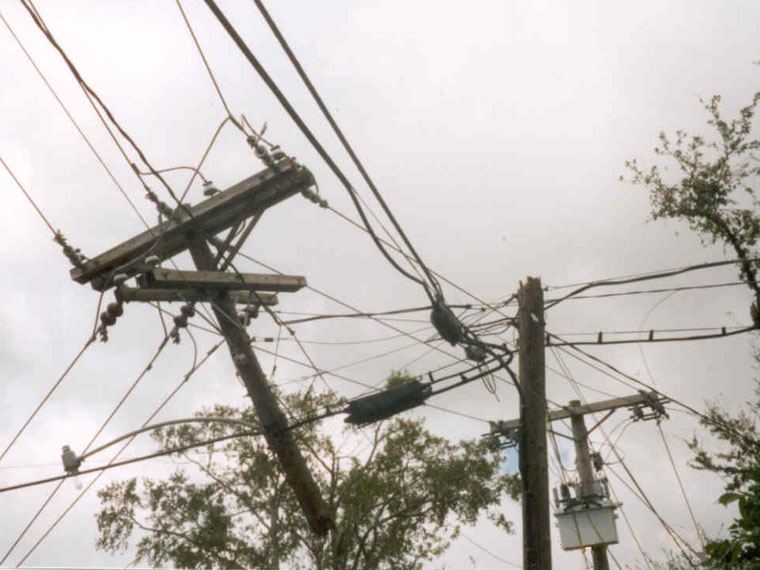


|
 |

(the eye of hurricane Lili slamming the Louisiana
coast)
Every year electric utilities suffer the wrath
of hurricanes that sometimes tear their systems apart. Many of
our clients have to deal with this impending threat every year. Our
friends and clients in the Carolinas have been spared from major
damage this year but the same cannot be said for Louisiana. Between 1900 and 1996 Louisiana was hit directly by 25
hurricanes. Cleco Power knows all too well of the destructive damage
a hurricane can have on an electrical system. Cleco Power is a
regulated electric utility company that serves more than 250,000
customers and operates over 2,000 megawatts of regulated generation.
Cleco Power has a service territory that covers approximately 14,000
square miles, its distribution system contains approximately 10,953
circuit miles, and has over 1,200 miles of transmission lines.
The Outage Management System used at Cleco Power
was co-developed by Cleco Power and Coulter Mapping Solutions, Inc.
and is a modified version of CMS’s AVTrouble Trouble Call System.
Modifications to AVTrouble were necessary to support the data model
of Cleco Power’s in-house developed GIS editing system and
multiple Distribution Operation Centers. The functionality supported
by CMS’s AVTrouble and Cleco Power’s OMS remained identical.
After Tropical Storm Isidore and
Hurricane Lili, a category 2 storm, made landfall, Cleco
was able to put their Outage Management System (OMS) through the test. We
asked Cleco Power about the hurricane damage and how the
Outage Management System faired.
How
many customers were affected by the hurricane?
Approximately 170,000 of more than 250,000
customers lost power during Hurricane Lili. This is 68 percent
of our customer base.
How long did it take to get all the
customers on line again?
The restoration effort took six days.
Were outside crews brought in to help
with repairs?
Yes
If so, how many crews from how many
utilities?
Sixteen companies including utilities
and contract companies assisted with restoration efforts. Over 1200
workers from eight states helped restore power. In addition,
over 900 tree trimmers from seven states assisted with tree clearing
efforts.
How many customers called in?
During a five-day period (Oct. 3-7),
Cleco's call center received 152,512 calls. This average of
30,500 calls per day compares to a "normal" daily average
of 2,400 calls.
How did the OMS help with the
disaster?
Because OMS groups all customer calls
associated with protective devices in a circuit, one benefit of the
system was identifying "nested" outages on newly restored
line sections. As customers reported service outages on newly
repaired circuits, crews were sent to those specific areas to
pinpoint and repair problems. This also allowed dispatchers to
utilize workers in the area to restore power quickly to customers.
The system helped report customer outage
counts more accurately and timely. Team leaders reported
restoration updates in each of the four areas of the service
territory twice daily. This information was sent to emergency
service agencies, the media, and city and state officials.
The OMS software gave storm team leaders
a better snapshot of outage situations. Distribution leaders knew the
extent of the storm damage and dispatchers quickly
determined which areas of the service territory were hardest hit and
deployed workers to those areas.
Before Cleco had OMS software, how
would a similar disaster have been handled?
In past storms, a worker in each of our
Distribution Operation Centers (DOC) tallied and logged customer
outage counts manually. The DOCs control the crews and work
completed in each division. Typically, Cleco operates three
divisions but the extensive damage from Hurricane Lili prompted
distribution team leaders to establish a temporary DOC to lead
restoration efforts in the heavily damaged south central area of
Louisiana. Had Cleco not had the OMS software, at least four
employees would have worked solely on tracking and updating customer
outage counts.
In the past, workers identified
"nested" outages manually. Line crews restored a circuit
and reported the completed job back to the DOC where workers
manually recorded the work. If a customer reported an outage
from a newly repaired circuit, workers manually reviewed completed
job orders to determine if the call came in before or after the
restoration. The time stamps on the OMS system immediately informed
the workers as to when work was completed on a circuit.

(Cleco crews working hard to restore power back to customers)

(Evidence of the destructive force of hurricane
Lili)
|

